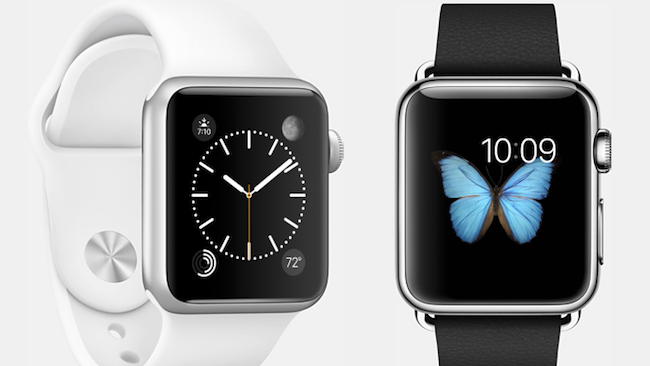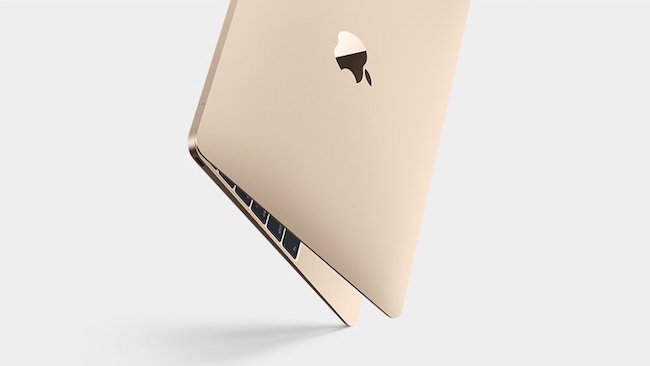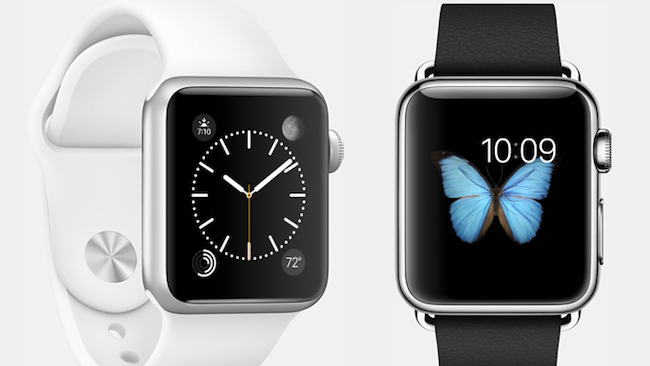
 Perfectly balanced? The new MacBook
Perfectly balanced? The new MacBook
Red Shark's Apple expert, K. Stewart, details the new ultra-thin 12-inch MacBook, the Apple Watch pricing and all the other announcements from an extremely packed and internet-breaking Apple keynote.
The first new product category of the Tim Cook era enjoyed its second keynote outing with a full reveal of the intricate, high fashion-oriented pricing matrix and launch date, but not too much in the way of new features despite speculation beforehand that Apple had been holding back killer-apps for competitive reasons. If the first keynote hadn’t sold you on Apple Watch, this wasn’t going to change your mind.
But let’s get the numbers out of the way first. Pre-orders start April 10th, with availability from the 24th. Pricing starts at £299 (38mm) and £339 (42mm) for the entry-level aluminium Apple Watch Sport with fluroreslastomer band, while the mid-range Stainless Steel Apple Watch starts £479/£519 with the same rubbery band and rises to £899/£949 for a Space Black model with Steel Link bracelet. The 18-carat gold Apple Watch Edition starts at £8,000 (with rubber strap!) and rises to £12,000 for a 42mm version with Midnight Blue Classic Buckle. Individual straps range from £39 to £379, but not all straps are available individually.

The higher level pricing was below some of the wilder estimates and is, in fact, comparatively cheap for a luxury watch… while still quite a way from any other digital watch to date. In terms of functionality, we basically got a rerun of the last keynote. To recap in the way that Apple would put it:
Apple Watch is the most advanced timepiece ever created, accurate to 50 milliseconds and with elaborately customisable faces, from traditional to digital, including an animated Mickey Mouse and a considerable range of notifications - the latter tied into Apple Watch aware apps such as, say, CNN for news alerts.
Apple Watch is a revolutionary new way to communicate, with the Taptic Engine allowing you to literally tap a friend on the wrist from the opposite ends of the Earth. It also has a microphone and speaker, to you can use it to answer the phone. At home, you can use your WiFi network to extend the range compared to Bluetooth - so your phone could be downstairs charging and you answer a call upstairs on your phone.
Apple Watch is like a personal trainer on your wrist. An elegant three ring display monitors your physical activities, with different setting for different gym equipment. It can even send you a weekly update to propose how you might improve your performance for the next week.
There’s an app for that
Normally, a major new product or even a significant iPad upgrade would see developers on stage to talk about exciting new apps. Given that the Watch is all about glimpses, about tiny little interactions maybe that wasn’t appropriate. We instead got Apple Technology VP Kevin Lynch giving us a ‘day in the life of Apple Watch’ with a range of small interactions such as call a cab with Uber, using Siri to set reminders, looking through Instagram, reading and responding to emails. The Wechat messaging popular in Asia worked well here due to its reliance on stickers to communicate.
Battery life had been a concern and Cook was happy to reveal it should do 18 hours before needing a charge - from an elegant magnetic charging device. Apple actually devotes a lot of space on the website to this issue, which is to say carefully managing expectations. 18 hours equates to - '90 time checks, 90 notifications, 45 minutes of app use, and a 30-minute workout with music playback from Apple Watch via Bluetooth.' If battery life gets too low, a Power Reserve mode should provide 72 hours of simply checking the time. Charge time is 2.5 hours to 100%.
As to water-proofing, Apple Watch has an IPX7 designation which means it can survive immersion in water up to 1 metre deep for up to 30 minutes. So getting caught in the rain or even having a shower will be fine, but swimming definitely isn't recommended.
In some early adopter reports, there’s been somewhat hyperbolic talk about the transforming impact of Apple Watch in lessening the need to pull out your iPhone and instead simply live through tiny glimpses of info on your wrist. Different people will have different usage applications, of course. There have also been questions about how well reliably turning your wrist turns on the screen — which unlike Pebble’s epaper display is high-resolution, full colour and needs to be off when you’re not looking at it.
In hands-on usage, the much vaunted digital crown (the faux winder on the side of the watch) seemed to be used less than expected — touching, scrolling seemed to work fine with force touch as an additional input. Some reported feeling the Digital Crown confused the UI more than it helped, although that may be due to limited time to get used to it.
Adding new apps will all be done via iPhone and iOS 8.2 appeared at the time of the keynote with an un-deletable new app to manage the Apple Watch you can't yet buy. What it does do is provide an entry into lots of Watch promotional material.
The most compelling use cases come from health, extending the increasingly powerful fitness apps from iPhone. Early on in the presentation, we had an insight into this from a new Research Kit framework for patients to self monitor and administer tests whenever they wanted - a key point being that disease symptoms vary over time and do not always present handily for a doctor's visit. The short film made a powerful case for its utility from doctors who normally struggle to get this sort of data and, to Apple’s credit, they’re open sourcing it to other platforms.
Reinvention of the notebook (again)
Apple has a habit of 'reinventing' the notebook, most notably of course with the ultra-thin MacBook Air and Retina-screened MacBook Pro. However, a degree of hubris is justified with Tim Cook proudly reporting the Mac has for the last 10 years out-performed the PC industry and in 2104 the MacBook enjoyed 21% growth while the PC market declined by 2%.
So for all Tim Cook's faith in the future of the iPad, there was no holding back in developing an all new MacBook designed to be the very definition of portability. Cook was obviously enjoying himself revealing the diminutive machine, before handing over to Marketing VP, Phil Schiller, to explain the key features.
Steve Jobs introduced the MacBook Air via a manila envelope, like a stage magician pulling off an unforgettable reveal. Phil Schiller began with the numbers. The new MacBook weighs just 2lbs and is 13.1mm at its thickest point — 24% thinner than previous thinnest MacBook.
According to Schiller, the size of the notebook is dictated by its full-size edge to edge keyboard. The travel of the keys is reduced, so the feel is distinctly different, but it's not a cheap feeling and after extended use may feel just as good or better - the technology is new with a butterfly mechanism which is 4x more stable and 40% thinner than a conventional scissor mechanism. There's also a new LED system to providing more precise illumination when typing in the dark.
Matching that edge-to-edge keyboard is a 12-inch Retina screen with a 2304 x 1440 display or 13.3 million pixels. It's an ultra-thin display, of course, just 8.8mm and uses 30% less energy for the same brightness as a standard Retina display. Schiller claims it's the best display ever built into a Mac, which will be interesting to test in a pro AV environment for those comparing against a MacBook Pro.
Apple's trackpads are a compelling competitive advantage; large, precise and of course with functionality seamlessly integrated into the OS. The new MacBook does away with the standard hinged approach, but instead uses a Watch-style Taptic engine to provide force feedback. As a default, despite being fixed in place, it actually feels just like the old one, and it also means you can alter the feel of the trackpad and it also enables a 'force click'. Due to Apple owning the OS and key applications it can and has implemented actions based on this - so for example in an email, force clicking on an address will bring up Apple Maps. There's a certain irony in Apple, long mocked for its one-click mouse, now offering perhaps the most sophisticated inputs on the market. How many people will actually use this functionality on a day-to-day basis remains to be seen, but again - like the keyboard - it's an encouraging sign that the drive to creating a thinner product hasn't prevented fresh thinking to also improve the experience. It also reinforces the link with Apple Watch where Force Touch was first developed and we can expect it to migrate across the entire Apple range in time.
The MacBook's unibody chassis also accommodates a terraced, contoured battery to provide 35% more capacity which helps ensure all day battery life with up to 9 hours wireless web. That's three hours less than the 13-inch MacBook Air, but the same as the 11-inch. The logic board is 67% smaller than the 11-inch MacBook Air and fan-less, so silent in operation. As expected, there's no switch to an iOS CPU, it's still Intel inside with an Intel Core M chip which runs off just 5 watts with an integrated Intel HD Graphics 5300.
Schiller called it Apple's vision for the future notebook - extreme portability, of course, and that meant wireless with 802.11ac and Bluetooth 4.0. The antenna is built into the edge, so no plastic sections are required to enable a good wifi signal. No wireless charging though, but as expected a single USB-C port for power, USB data, DisplayPort, HDMI, and even VGA, Interestingly, Schiller stressed it's a new industry standard, so we can expect dongle adaptors from third-parties as well as Apple. (A USB-C Digital AV Multiport Adapter is £65 from Apple by the way, while USB-C to USB is £15. The former goes some way to its justifying the price point by enabling a simultaneous video-out, USB charge and USB data connection so it's actually more a dock.)
The MacBook comes in Silver, Space Grey and Gold and Apple insists it's the world's most energy efficient notebook.
When the original MacBook Air was introduced it was under-powered and over-priced for most applications. Quite how well the new MacBook performs given its fan-less design, remains to be seen. It's not going to be anyone's first choice for gaming or video editing, but at a starting price of £1049 for a retina screen with 8GB RAM and 256GB SSD it's not cheap, but at least the entry-level RAM and SSD are reasonably specced in performance terms for once. The more expensive model doubles storage to 512GB and comes with a faster 1.2GHz dual-core, but at £1299 really does infringe on MacBook Pro territory and emphasises that, right now, thinness comes with a real price/performance hit - all the more so when you consider the low-power Core M CPU is broadly equivalent to a full-fat Ivy Bridge chip from a 2012 MacBook. Consider your usage scenarios carefully before putting in an order with April 10th down as the shipping date.
MacBook Air & Pro, Apple TV and pointers to the future
Clearly the new MacBook isn't yet priced for entry-level, so the non-Retina MacBook Air is being retained, with an upgrade to fifth-generation Broadwell-U Intel Core i5 and i7 processors, Thunderbolt 2 and, for the 13-inch model, flash memory is upgraded to be twice as fast as before. The MacBook Pro line-up is also updated with a Force Touch trackpad, faster i5 and i7 processors, flash memory speed is again doubled, plus another hour of battery life. All of these models are shipping now, so if you've just bought one it's worth reading about Apple's returns policy.
No 4KTV set, not even a chipset upgrade for Apple’s hockey puck media streamer, but a significant price cut from $99 to $69 served as the perfect accompaniment to the US launch of HBO NOW for just $14.99 and no long-term commitment. Apple is the exclusive launch partner for HBO NOW (for a three month period, which will tie in nicely with Season 5 of Game of Thrones) and HBO CEO, Richard Plepler, was on stage to talk about this 'transformative moment for HBO.'
Sadly no news, as yet, of a UK release date - HBO NOW is US-only at launch - but this is a significant boost for the Over The Top (OTT) media distribution model. Existing broadcast and cable/satellite networks will feel renewed pressure to adapt by offering their own OTT services and, of course, looking to 4K services as a possible means of differentiation - or at least keeping up with what Netflix is already doing.
Staking a claim to the future
Early on in Tim Cook’s tenure, Google Glass appeared to be the future and Apple looked in danger of being side-lined by Android and Samsung. The ‘back-to-the-drawing-board’ status of Glass and the runaway success of large screen iPhones have dramatically reduced that pressure. Without the pressure of needing to ‘save’ Apple, the Apple Watch looks to be a useful extension of the iPhone experience (and has very limited functionality outside its range) but should establish Apple in the wearable future with some panache.
There remains, however, a paradox in appropriating so much of the language of luxury, hand-built time pieces that go unchanged for decades by a consumer tech company that lives off delivering upgraded new hardware year after year. There was speculation before the event that the modular nature of the Apple Watch chip itself might open the door to an upgrade path, particularly for the gold Watch Edition. Maybe that's still to come, but there was no mention of it at the event.
In the world of luxury watches, the gold Apple Edition Watch is relatively cheap so maybe it doesn't matter that much, however, for the mid-range Apple Watch where it's easy to spend a thousand pounds with a link strap, you wonder at the price/ functionality return with a consumer tech life-span. After all, if Apple Watch is managing 18 hours when new, what will that look like in two years with more ambitious apps?
The keynote wrapped up not with new apps, but with three short videos on the specialness of the aluminium, stainless steel and gold alloys Apple had developed for the casings. Christy Turlington Burns, supermodel and charity spokesperson made an appearance to promote her work and a top-of-the-range watch strap, while Cook was careful to show he was happy with a basic model and rubber strap.
April 10th pre-orders will be accompanied by the opportunity to book appointments and personally try out different watch combinations and it’s never been more important to experience an Apple product before ordering. As easily the most valuable corporation on Earth, it’s good to see Apple taking risks and doing the unexpected, how well it will turn out for the first generation product line may well not be clear until this time next year and Apple Watch 2.0.
Tags: Technology


Comments